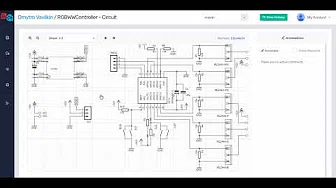Files
Scanning the repository...
Last update 6 years 8 months
by Emanuele Giacomini
| FilesrefTUTTO PIXYexamplesline_zumo_demo | |
|---|---|
| .. | |
| line_zumo_demo.ino |
line_zumo_demo.ino// // begin license header // // This file is part of Pixy CMUcam5 or "Pixy" for short // // All Pixy source code is provided under the terms of the // GNU General Public License v2 (http://www.gnu.org/licenses/gpl-2.0.html). // Those wishing to use Pixy source code, software and/or // technologies under different licensing terms should contact us at // cmucam@cs.cmu.edu. Such licensing terms are available for // all portions of the Pixy codebase presented here. // // end license header // #include <Pixy2.h> #include <PIDLoop.h> #include <ZumoMotors.h> #include <ZumoBuzzer.h> // Zumo speeds, maximum allowed is 400 #define ZUMO_FAST 200 #define ZUMO_SLOW 150 #define X_CENTER (pixy.frameWidth/2) Pixy2 pixy; ZumoMotors motors; ZumoBuzzer buzzer; PIDLoop headingLoop(5000, 0, 0, false); void setup() { Serial.begin(115200); Serial.print("Starting...\n"); motors.setLeftSpeed(0); motors.setRightSpeed(0); pixy.init(); // Turn on both lamps, upper and lower for maximum exposure pixy.setLamp(1, 1); // change to the line_tracking program. Note, changeProg can use partial strings, so for example, // you can change to the line_tracking program by calling changeProg("line") instead of the whole // string changeProg("line_tracking") pixy.changeProg("line"); // look straight and down pixy.setServos(500, 1000); } void loop() { int8_t res; int32_t error; int left, right; char buf[96]; // Get latest data from Pixy, including main vector, new intersections and new barcodes. res = pixy.line.getMainFeatures(); // If error or nothing detected, stop motors if (res<=0) { motors.setLeftSpeed(0); motors.setRightSpeed(0); buzzer.playFrequency(500, 50, 15); Serial.print("stop "); Serial.println(res); return; } // We found the vector... if (res&LINE_VECTOR) { // Calculate heading error with respect to m_x1, which is the far-end of the vector, // the part of the vector we're heading toward. error = (int32_t)pixy.line.vectors->m_x1 - (int32_t)X_CENTER; pixy.line.vectors->print(); // Perform PID calcs on heading error. headingLoop.update(error); // separate heading into left and right wheel velocities. left = headingLoop.m_command; right = -headingLoop.m_command; // If vector is heading away from us (arrow pointing up), things are normal. if (pixy.line.vectors->m_y0 > pixy.line.vectors->m_y1) { // ... but slow down a little if intersection is present, so we don't miss it. if (pixy.line.vectors->m_flags&LINE_FLAG_INTERSECTION_PRESENT) { left += ZUMO_SLOW; right += ZUMO_SLOW; } else // otherwise, pedal to the metal! { left += ZUMO_FAST; right += ZUMO_FAST; } } else // If the vector is pointing down, or down-ish, we need to go backwards to follow. { left -= ZUMO_SLOW; right -= ZUMO_SLOW; } motors.setLeftSpeed(left); motors.setRightSpeed(right); } // If intersection, do nothing (we've already set the turn), but acknowledge with a beep. if (res&LINE_INTERSECTION) { buzzer.playFrequency(1000, 100, 15); pixy.line.intersections->print(); } // If barcode, acknowledge with beep, and set left or right turn accordingly. // When calling setNextTurn(), Pixy will "execute" the turn upon the next intersection, // making the left or right branch in the intersection the new main vector, depending on // the angle passed to setNextTurn(). The robot will then follow the branch. // If the turn is not set, Pixy will choose the straight(est) path by default, but // the default turn can be changed too by calling setDefaultTurn(). The default turn // is normally 0 (straight). if (res&LINE_BARCODE) { buzzer.playFrequency(2000, 100, 15); pixy.line.barcodes->print(); // code==0 is our left-turn sign if (pixy.line.barcodes->m_code==0) pixy.line.setNextTurn(90); // 90 degrees is a left turn // code==5 is our right-turn sign else if (pixy.line.barcodes->m_code==5) pixy.line.setNextTurn(-90); // -90 is a right turn } }








